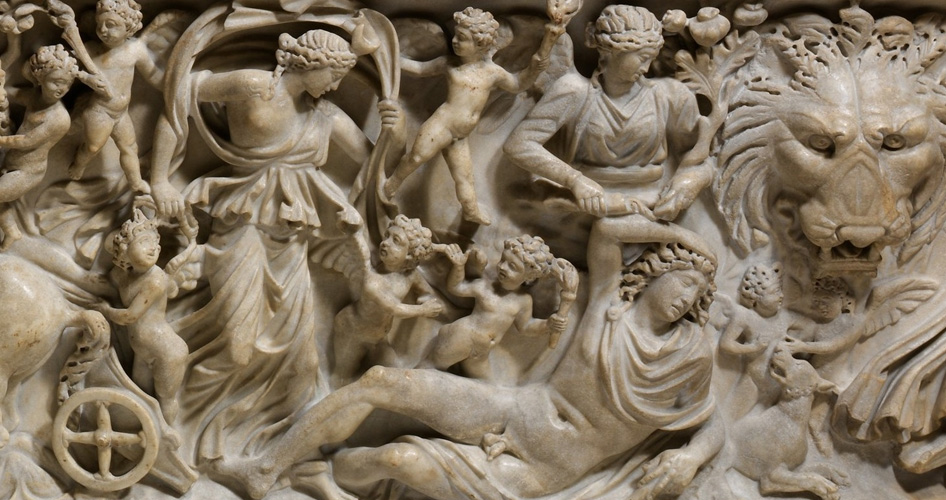
The Myth
The myth of Selene and Endymion is about a rare female pursuit. The moon goddess, Selene, falls in love with the mortal Endymion. Endymion is said to be a shepherd, a hunter, or a king. Selene visited her sleeping love in the night as she rode her moon chariot across the night sky. She would come down to earth just to be with the beautiful Endymion.
“Or else, looking down on thee from the starry heavens, the orb [Selene the moon] that was born after the old Arcadians will lose control of her white-shining car [for love of a rustic, like Endymion]. And lately she blushed fiery red, though no staining cloud obscured her bright face”
– Seneca, Phaedra 786
Selene wished to be with Endymion forever so she asked Jupiter to grant her lover eternal sleep so that she may visit him every night. Other translations claim that it was Endymion’s choice to remain unchanged and forever asleep.
“[Endymion] a man of unrivalled beauty, he was loved by Selene. When he was given a wish of his choice by Zeus, he chose to remain immortal and unaging in eternal sleep.”
– Pseudo-Apollodorus, Bibliotheca 1. 56 (trans. Aldrich)
Themes and Motifs
This myth was popular among love poets and artists, and it translated well on mythological Roman sarcophagi. Sleep in this funerary context should be read as kind of death.[1] All sarcophagi of this myth share the similar composition of Selene approaching a reclining Endymion. The depiction of this myth offered several allegories and messages. One allegory it provided was the eternal love between goddess and mortal, or husband and wife, which survives even during his endless sleep. A celestial marriage continues through the ages. Another provides “a sexual metaphor for the joys of the blessed life to come.”[2] The deceased were depicted in the guise of these two mythological lovers. By including the wife as Selene and the husband as the sleeping Endymion, this makes the claim “I loved my husband and I miss him the way Selene missed Endymion.” Viewers would take away this message and see just how much the married couple loved each other.[3] In these types of sarcophagi, several Erotes are included. This is seen also in the sea sarcophagi and the Bacchus and Ariadne sarcophagi. There are nearly one hundred different version of the Selene and Endymion scene in marble sarcophagi relief. Though the composition is similar, no version is an exact replica of another.
The kind of love in these mythological sarcophagi is one of longing. We see Selene approaching her beloved but we never actually see the two embrace. By having the setting be rustic and peaceful, the hope of the living for the deceased to have a carefree and idyllic rest is evident.[4] The Selene and Endymion sarcophagi evoke marital love, physical pleasures, and the longing to be reunited with a loved one. There is a hope that the two lovers will see each other again, if not in the next world, then at least in their dreams. Sleep not only represents a temporary and blissful slumber, but also alludes to the sweet dreams to follow.
Examples

One Endymion sarcophagus at the Metropolitan Museum of Art in New York dates from circa 150—160 AD and was found in the outskirts of Rome (Figure 20). Endymion, in the nude, enjoys eternal sleep and reclines. Selene steps off her moon chariot and approaches the mortal. In this depiction Endymion is a shepherd. The comparison of Endymion to a shepherd evokes the peacefulness and idyllic countryside loved by many romantic poets. This kind of peace is desired for the deceased.[5]
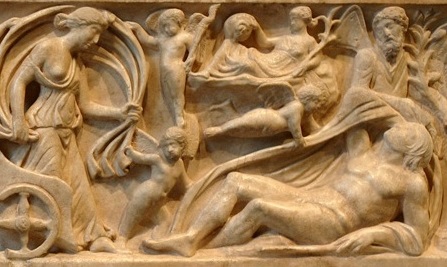
On the far right is the sleeping Endymion, the focus of the story. His arm is raised over his head in a sensual way and his face tilted upward toward the sky. The male personification of sleep is shown with moth wings holding poppies in one hand and pouring a sleeping potion over the mortal with his other (Figure 20, Detail A). A small Eros pulls away Endymion’s draped cloak, revealing his naked body to the approaching Selene. This revealing gesture was also seen in sarcophagi of Bacchus and Ariadne. Selene is identified by the crescent moon on her forehead and the round billowing veil around her. Another Eros holds a torch, shining light onto Selene’s lover. The female personification of the breeze, Aura, holds Selene’ horses as she goes to Endymion. On the far left is an anonymous sleeping shepherd boy surrounded by his herd of rams and goats.[6] This depiction is much simpler than later versions of this myth on sarcophagi but the same major elements and figures remain constant.
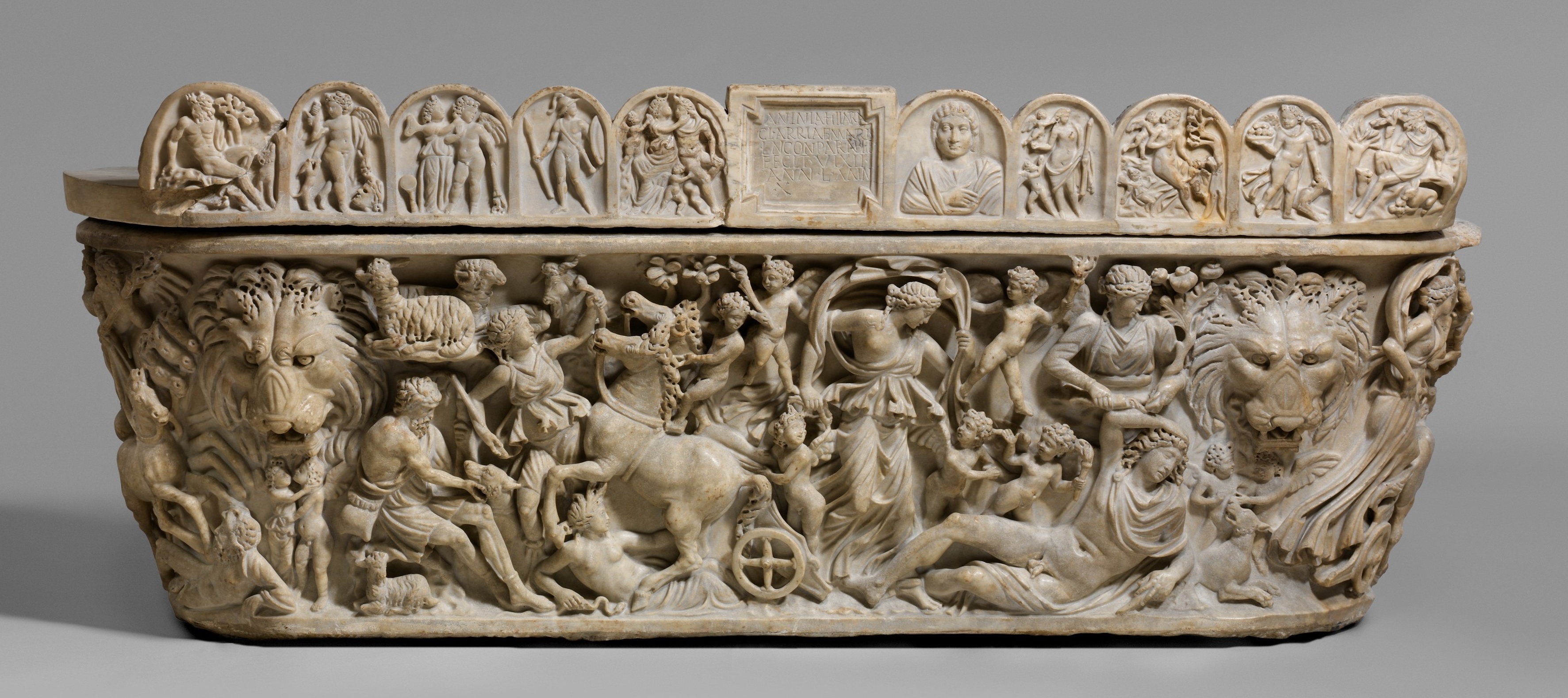
Another Endymion sarcophagus, also found at the Metropolitan Museum of Art, dates from circa 190—210 AD (Figure 21). This sarcophagus, far more elaborate than the last, was rounded along the edges which gave the sculptor more space to compose the scene. Endymion is shown in the same position as the previously mentioned sarcophagus but his face is turned downward.
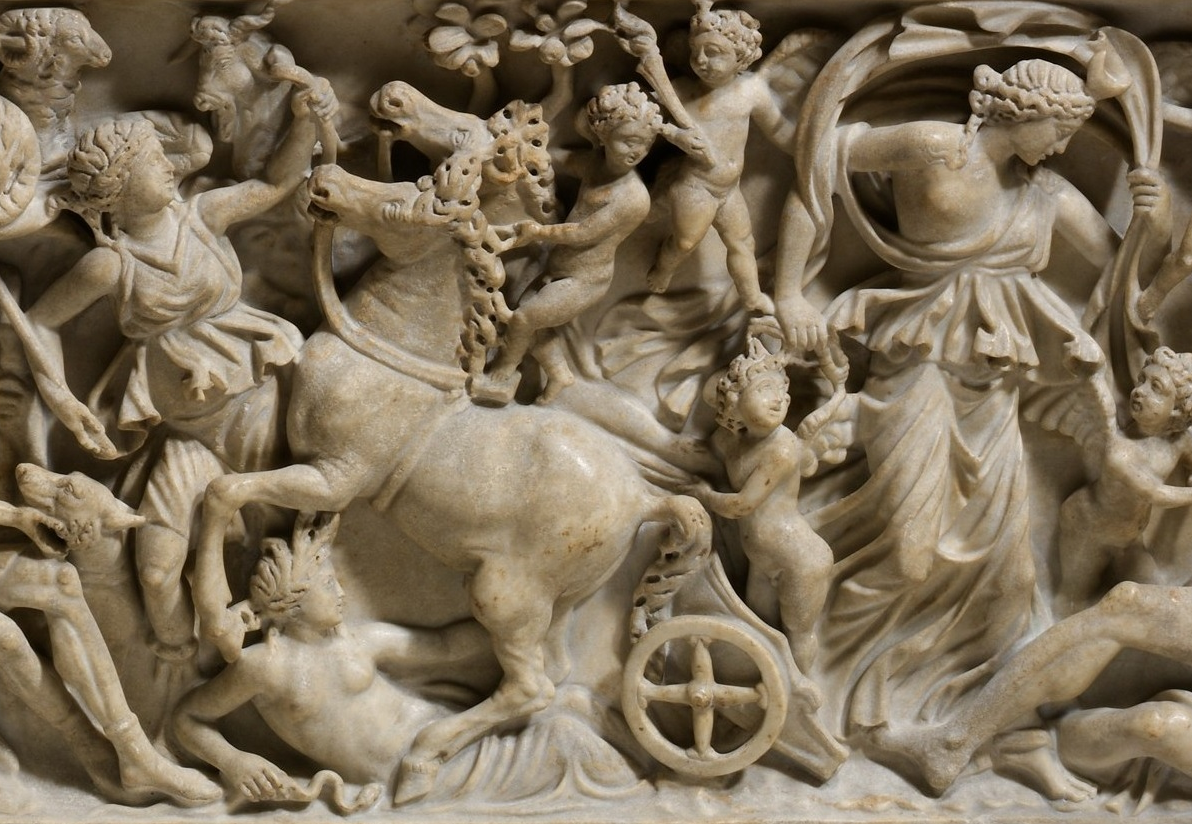
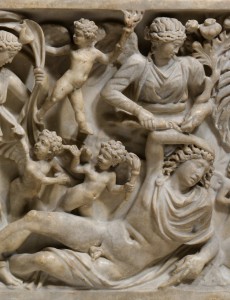
Behind the sleeping mortal stands the female personification of night holding poppies and pouring a sleeping potion over him. Selene steps from her chariot with her flowing veil while Erotes illuminate the scene with torches (Figure 21, Detail B). On the two sides of this sarcophagus are depictions of the sun god and the moon goddess. Selene is shown here a second time, except this time she is riding her moon chariot across the sky led by Aura. Below Selene and her horses reclines the personifications of the ocean and the earth (Figure 21, Detail A). These two figures could have been included to represent the deceased’s decent from earth to the heavens. On the back of this sarcophagus is another rustic scene showing horses and bulls grazing between two herdsmen. A portrait with accompanying inscription of the deceased is located on the lid.[7]
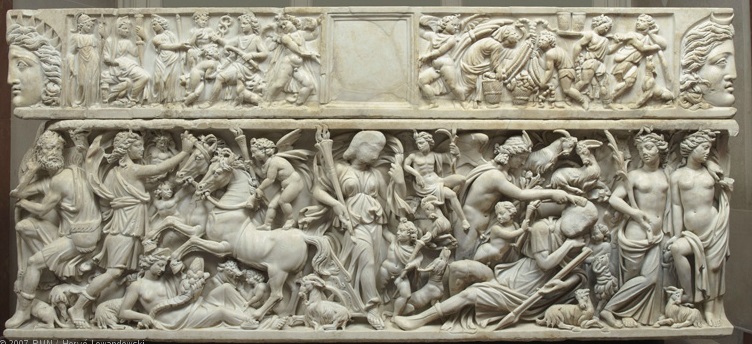
A third sarcophagus in the Louvre Museum in Paris dates from about 235 AD. Selene is shown once again stepping from her chariot (Figure 22). Her beauty and gracefulness would have served as a compliment to the deceased wife, whose likeness the goddess would have been shown in. The face of the goddess is blank, ready for a portrait. Endymion is shown with a short tunic, cloak, and hunting spears, suggesting a skilled hunter (Figure 22, Detail A). He is young and muscular as well.

Erotes hold torches again, illuminating the scene while shepherds are guarding their herds around the edges of the main composition. A rustic and peaceful scene is composed and once again, the lovers are surrounded by peace and harmony in the countryside. This particular sarcophagus was the pendant to a compositionally similar sarcophagi of Bacchus and Ariadne, also at the Lourve. The myth Bacchus and Ariadne relates to the myth of Selene and Endymion through the motif of sleep. To learn more about this pendant myth, see the Bacchus and Ariadne section under Sweet Dreams.
[1] Michael Koortbojian, Myth, Meaning, and Memory on Roman Sarcophagi (University of California Press E-Books Collection, 1995), Chapter 4
[2] Ibid., Chapter 5
[3] Paul Zanker, “Reading images without texts on Roman sarcophagi,” Res 61/62 (2012), 168
[4] Friedrich Matz, “An Endymion Sarcophagus Rediscovered,” The Metropolitan Museum of Art Bulletin 15 (1957), 126
[5] Paul Zanker, “Reading images without texts on Roman sarcophagi,” Res 61/62 (2012), 171
[6] Anna Marguerite McCann, Roman Sarcophagi in the Metropolitan Museum of Art (The Metropolitan Museum of Art, New York, 1978), 34-35
[7] Ibid., 39-43